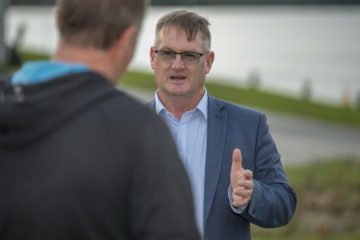The Psychology of Winning: How to Develop a Winning Attitude in High Performance Sport

The team gathers in the locker room.
This is an intense, high pressure environment that few experience and even fewer survive.
A former player – one of the nation’s greatest – walks into the change room. There is a respectful hush as he starts to speak.
He talks about pride.
He talks about spirit.
He talks about commitment – about attitude.
He talks about winning – the history of the nation at the world cup.
With tears in his eyes he begins to recite the names of the great players who have gone before.
He asks players to stand and link arms and to join him in the national anthem.
He has done a great motivational talk.
This is the perception many people have about the word motivation as it applies to high performance sport: a one off emotion charged lecture from a professional speaker or motivator or sports psychologist.
Motivation is…..
Effective motivation is not a one off talk by a high powered speaker.
It is not the promise of a present or gift or bag of money.
It is not a single temporary burst of emotion.
Effective Motivation is a lifestyle. Motivated people live a lifestyle where they are motivated to achieve excellence in everything they do. Every task, every activity, every challenge is an opportunity to set a goal, to try something new and to achieve.
The way you do anything is the way you do everything
Try this simple exercise.
Have several athletes sit together before their next training session. Ask them to perform a simple task – making a paper plane. Demonstrate how you would like them to make the plane.
Now give them three minutes to perform the task and observe the athletes performing their task.
Some athletes will fold the paper so that it looks roughly like the demonstration version. Others will fold and bend the paper so that it is identical in most ways to the demonstration version but with small variations in the shape and size of the folds here and there.
Perhaps one athlete will ensure that every fold is even and smooth. They will make certain that the left and right sides of the plane are balanced and symmetrical. They may even put in a couple of extra folds on the wing to try and make a more advanced design.
And that’s the attitude coaches and athletes should aim to foster – the attitude to do every task – regardless of its nature – to the best of their own ability.
Where the other athletes have asked of themselves “Can I do this” or “How can I do this”, one athlete has asked “How can I do this well and maybe even do it better than expected”. The athlete has challenged him/herself and been motivated to complete a relatively simple task to the best of his ability.
How does this relate to sport and training?
Consider the above example in terms of a training activity.
The coach asks the team to perform a drill – in this case dribbling a ball through a set of “cones”.
The coach demonstrates the skill, discusses the aim of the activity, asks for questions, demonstrates again and then steps back to allow the players to try the activity.
As with the paper plane, the coach observes a range of behaviours from his players as they try the drill several times.
- Player one performs the drill correctly.
- Player two also performs the drill correctly but adds an element of speed into the activity to test their skill level when moving faster.
- Player three also performs the drill correctly. He also tries to perform the drill at speed but adds an element of practical and applied thinking by shooting at a nearby goal at the completion of the drill.
This is the challenge for coaches. There is nothing wrong with what Player one did. He followed the instructions of the coach and performed the activity as required. However, Player two and Player three challenged themselves to perform the task to a higher standard than what was required.
For some reason they were motivated to perform a simple task given to them by their coach to the best of their ability. They decided to set a more challenging goal and then worked to achieve it.
Player one was involved in the activity. Players two and three were committed to the activity. They approached a relatively simple task with the commitment to do it well.
How do coaches turn this involvement into commitment?
Much of the success of these motivated athletes comes from their ability to set challenging goals and to manage the process of achieving their goals.
The great news is that goal setting and goal management is a simple concept for athletes to learn because that is the way we all work every day in everything we do.
For example.
Goal: I want a cup of tea.
Solution: I will make one.
Goal: I would like to earn some money.
Solution: I will apply for a job.
Our brains work in terms of setting goals and achieving them. Goal setting is a very natural process and humans are by nature very goal orientated.
In high performance sport, the challenge for coaches and athletes is to set high performance goals and to achieve them through high performance practices and attitudes.
It has been said that the key to success is to develop “the will to win”. However, the will to win is not worth anything without the daily commitment to do what it takes to prepare to win. It is common for athletes to want to win – but how many support this desire to win with focus and concentration and determination in everything they do?
The U.S. Olympic Training Centre
There is a sign on the door of the United States Olympic Training Centre dining room. The same sign is on the gym doors and on the doors to other training venues in the Olympic Training Centre. It is all over the Centre so that athletes, coaches, sports scientists and administrators can see it and be reminded of it constantly. It says:
Not Every Four Years, Every Day
This simple sign reminds every individual involved in high performance sport that excellence comes from things practiced and mastered in every training session, every day: that Olympic success every four years comes from the little successes achieved every time an athlete runs, swims, lifts weights, stretches etc etc.
Group training activities by their nature often mean that individualised training is difficult for the coach to establish. Different levels of fitness, maybe different ages, different levels of ability and so on mean that often training activities can not be set precisely for each athlete.
Most commonly in these situations, the coach prescribes training activities at an “average level”. That is the training tasks are not too demanding for the players of lower ability nor are they too easy for the talented players.
However, it is not the task, but how the players attack the task that makes all the difference.
It is not what you do, but HOW you do it that matters.
Discussions on the topic of training programs, of variations in volume and intensity, of percentage of training done in the various training zones, of the types of exercises to do etc are important. Coaches, athletes and sports scientists regularly debate the positives and negatives of what to do.
However, it is the how they (the athletes) do it that is vital to the success of the training program.
Leading USA Swimming Coach Mark Schubert said recently, “A coach told me that he had a poor taper and subsequently his swimmers had performed poorly at their state championships. I replied, “You didn’t have a poor taper – you had a poor season of training”. “It’s the little things your athletes do everyday in training, their attitude to every training session and their commitment to every task they attempt in their program that determines how well they do in competition. A great taper will not save you from a poor training effort”.
Successful people (and athletes) rely heavily on setting and achieving goals – little targets to achieve in their daily lives that provide focus and motivation. The cumulative effect of setting and achieving these small daily goals can be enormous and lead to success at the highest levels.
For example in soccer drills:
Coaches instruction: Perform the drill correctly.
The players then interpret the coaches instructions in one of several different ways:
- Player one – Goal: Perform the drill correctly.
- Player two – Goal: Perform the drill correctly as fast as I can.
- Player three – Goal: Perform the drill correctly as fast as I can without making any errors and shoot for goal at the end.
Each player has set a goal and aimed to achieve it. However, each player has set different goals based on their level of ability, confidence, past experience and other factors.
Make it Happen: Let it Happen
Many athletes suffer from “nerves” – being anxious and nervous on the day of competition.
This is because 90% of all STRESS comes from not doing things when they were supposed to be done!
One of the great challenges coaches and athletes face is allowing training to be completed at a standard lower than their expected competition performance.
Many athletes muddle through training doing the minimum standard of effort and application only to find that their competition performances are also lack lustre.
Why? In training they have let it happen – they have allowed training to become a place where sub standard skills and poor habits become acceptable practices. Then when they go to the competition and try to make it happen (i.e. force a successful performance to occur) they find they lack the skills, fitness and abilities to produce a winning effort.
Conversely, successful athletes have an attitude that makes it happen in training. They apply the same focus and intensity in training that they apply in competition. As a result, on competition day, they can relax knowing that they can let it happen – success is more likely to occur because of their attitude in training.
Leading Australian swimming Coach Lawrie Lawrence once said of confidence in competition, “Nothing gives an athlete confidence like knowing they have done everything they possibly could have done to their best of their ability in training and preparation”.
The key to this approach is: Train as you would compete.
If athletes learn to commit to achieving excellence in everything they do in training and to apply the same focus and determination to training well as they do to competing, they create an environment of excellence in their club or training group. This attitude can make a significant difference to all the athletes in the group or squad.
As a wise coach once said, “Attitudes are contagious – is yours worth catching?”
Summary
Successful training programs help athletes develop a wide range of skills and abilities. Over a training season, athletes develop the characteristics they require to achieve their best in competition through a logical sequence of periodized training activities.
It would not make sense for a sprinter to wait until the morning of their first race of the season to start practicing speed development techniques.
It is not logical for a soccer player to start practicing kicking techniques on the morning of the first game of the year.
It therefore is not sensible to wait until the day of the big race or big game to try and develop mental skills. Mental skills need to be developed in every session, every day and in every training activity. By establishing and reaching training goals every day in practice, athletes develop the confidence and belief that anything is possible in competition.
If success in High Performance sport is as many people suggest, “99% mental”, then neglecting daily mental skills training is to neglect the key to competition success.
In many ways success is a choice – as it comes from the decisions and choices athletes make in every training and competition situation.
Wayne Goldsmith



1 Comment
Sonja Clement · November 23, 2024 at 7:39 pm
This has to be one of the best articles I have read
in the area of youth athletes mental coaching. It cleared all the mystery in the confusing world of sports psychology by presentihg a simplified, doable method to help our children achieve their goal.
Thank you so much Wayne! My teenage children also loved it.